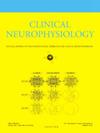帕金森氏病在从稳定位置开始的步进过程中,下肢表达视觉运动反应得以保留
IF 3.6
3区 医学
Q1 CLINICAL NEUROLOGY
引用次数: 0
摘要
虽然帕金森病的运动损伤研究得很好,但人们对帕金森病(PwPD)患者如何将视力迅速转化为行动知之甚少。这些转变可以通过测量视觉运动表达反应(evr)来研究,evr是一种刺激导向的肌肉活动爆发,被认为起源于上丘,通过构造-网状脊髓通路到达外周。方法对20例PwPD患者和20例健康对照(HC)进行目标定向步启动过程中下肢evr的检测。由于年轻人的下肢evr已被证明与姿势控制相互作用-姿势控制在PwPD中经常受到影响-我们通过改变立场宽度和目标位置来操纵姿势需求。结果在低体位需求下,两组evr表达一致。PwPD患者EVR值显著升高,但随疾病严重程度的增加而降低。在高姿势要求下,evr被抑制,随后是强烈的预期姿势调整,PwPD的evr比HC小。结论在帕金森病早期,介导evr的神经回路可能被上调,以补偿日常生活中经历的运动缺陷,但随着帕金森病的进展,神经回路会逐渐受损。这些发现为健康和疾病快速发展的神经基础提供了新的见解。本文章由计算机程序翻译,如有差异,请以英文原文为准。
Lower-limb express visuomotor responses are spared in Parkinson’s disease during step initiation from a stable position
Objective
While motor impairments in Parkinson’s Disease are well-studied, less is known about how people with Parkinson’s Disease (PwPD) can nevertheless rapidly transform vision into action. These transformations can be studied by measuring express visuomotor responses (EVRs), which are stimulus-directed bursts of muscle activity thought to originate from the superior colliculus, reaching the periphery via the tecto-reticulospinal pathway.
Methods
We examined EVRs in the lower limbs during goal-directed step initiation in 20 PwPD and 20 healthy controls (HC). As lower-limb EVRs in the young have been shown to interact with postural control – which are often affected in PwPD − we manipulated postural demands by varying stance width and target location.
Results
Under low postural demand, both groups expressed consistent EVRs. EVR magnitudes were significantly higher in PwPD, yet decreased with greater disease severity. Under high postural demands, EVRs were suppressed and followed by strong anticipatory postural adjustments, which were smaller in PwPD compared to HC.
Conclusions
The circuit mediating EVRs may be upregulated in early PD to compensate for motor deficits experienced in daily life, but becomes progressively impaired as PD advances.
Significance
These findings provide novel insight into the neural underpinnings of rapid stepping in health and disease.
求助全文
通过发布文献求助,成功后即可免费获取论文全文。
去求助
来源期刊

Clinical Neurophysiology
医学-临床神经学
CiteScore
8.70
自引率
6.40%
发文量
932
审稿时长
59 days
期刊介绍:
As of January 1999, The journal Electroencephalography and Clinical Neurophysiology, and its two sections Electromyography and Motor Control and Evoked Potentials have amalgamated to become this journal - Clinical Neurophysiology.
Clinical Neurophysiology is the official journal of the International Federation of Clinical Neurophysiology, the Brazilian Society of Clinical Neurophysiology, the Czech Society of Clinical Neurophysiology, the Italian Clinical Neurophysiology Society and the International Society of Intraoperative Neurophysiology.The journal is dedicated to fostering research and disseminating information on all aspects of both normal and abnormal functioning of the nervous system. The key aim of the publication is to disseminate scholarly reports on the pathophysiology underlying diseases of the central and peripheral nervous system of human patients. Clinical trials that use neurophysiological measures to document change are encouraged, as are manuscripts reporting data on integrated neuroimaging of central nervous function including, but not limited to, functional MRI, MEG, EEG, PET and other neuroimaging modalities.
 求助内容:
求助内容: 应助结果提醒方式:
应助结果提醒方式:


